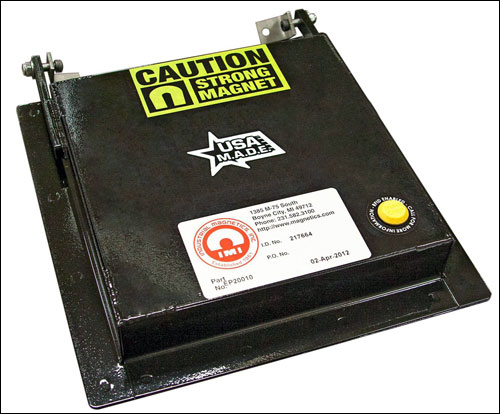Industrial Magnetics Inc. (IMI) intends to help its customers and its own inspectors collect and store accurate inspection and maintenance data for magnetic separators used by manufacturing plants to extract metal from products. In this effort, the company has been attaching a passive high-frequency (HF) 13.56 MHz RFID tag to each of its magnetic separators since early this year. Users who wish to service or inspect the separators can read data related to every item via a handheld RFID interrogator. The tags are provided by InfoChip Systems Inc.
IMI, based in Michigan, provides industrial magnets and magnetic products designed to hold, lift, convey or separate metal objects. Magnetic separators are employed at bulk-processing plants, especially those operated by food companies striving to ensure that no stray metal ends up in products. Such companies can position the magnetic separators near vats of processed food, for example, to extract even tiny fragments of metal that might have broken loose from factory equipment during manufacturing.
According to the company, the magnetic separators need to be inspected regularly in order to verify that they function properly, which requires that inspectors conduct a “pull test.” The work is performed either by a factory’s own staff, or by Industrial Magnetics’ inspectors. In fact, IMI offers the service free of charge, inspecting its own separators, as well as those of other providers, and supplying an end user with any recommendations in the event that the inspectors deem the separators in need of adjustment or repair, or decide that additional separators are necessary.
In recent years, IMI reports, the quantity of separators put into operation has increased—primarily to meet food-safety controls—thereby making it difficult to manage all separators on a plant floor, where there may be 30 or more of the devices in place. Tracking the inspections and service history of each item requires that an inspector locate its serial number, which can often be difficult to read. Because the food industry has extremely strict sanitation requirements, the separators are frequently cleaned at high temperatures, and serial numbers can be washed off in the process. With RFID, a visible serial number is no longer necessary, says Peter Friedrich, IMI’s distribution manager, and the inspection process is thus made faster, and data much easier to access and input.
The company is presently attaching an InfoChip DuraDisc RFID tag—measuring 0.75 inch in diameter, designed for extreme environments and mounted via an adhesive—to each of the magnetic separators it sells, and plans to apply the tags to a customer’s existing separators as a retrofit, upon request. There is no additional charge for the RFID tags, IMI reports. Customers wishing to utilize the tags can acquire their own handheld readers, along with software to manage the read data, or they can use hardware and a hosted software service provided by InfoChip. The company’s owner, Tom Bamford, says InfoChip can provide its Bluetooth Easy Reader, which can capture the HF RFID data and forward it to another device, such as a tablet PC, via a Bluetooth connection. InfoChip software, residing on the firm’s hosted server, captures the unique ID number encoded to each RFID tag.The tag’s ID number can be linked to data regarding the separator, and can then be transmitted to the user’s existing enterprise resource planning (ERP) system, or to the cloud-based server hosted by InfoChip. In the latter scenario, the tag’s ID is linked to its history, which could include its date and place of manufacture, its installation date and any services provided, such as pull tests.
While inspecting a separator, an inspector would read the tag and respond to prompts in the InfoChip software (or in the company’s own software) indicating which services were being provided, as well as the results of any testing, and that data would then he stored either on InfoChip’s server, or on the user’s own back-end system.
InfoChip’s software provides alerting in the event that an item is overdue for inspection, and also stores each separator’s maintenance history. The alerts can be delivered in the form of a message e-mailed to the company’s management, or be displayed on the handheld at the time that a tag is read.
Friedrich says IMI’s own inspectors are still manually inputting serial numbers and inspection details into a Microsoft Excel spreadsheet that the company provides to customers. In cases in which a user requests RFID-based data, however, the inspectors will read the tags and store that information on the user’s software system of choice.
With the technology in place, Friedrich says, IMI is now able to offer a service not provided by its competitors. RFID is thus a value-add that makes magnetic-separator maintenance more efficient for its customers.
According to Bamford, InfoChip has been providing asset-tracking solutions, including rugged RFID tags and readers, to the industrial market since 2002, with approximately two million chips currently in use.



